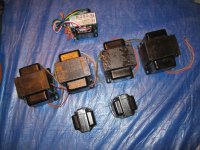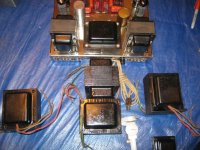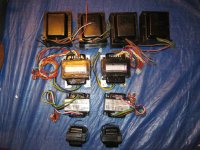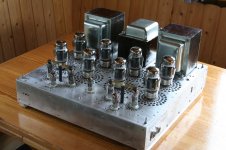I have been collecting parts for a few large output amps. I want to do one 200w stereo all on one chassis and then I want to do a pair of 200w mono amps,
I know this is a huge adventure, I am up to the Challenge as long as I have good help.
I have the power. and the tubes what I need is a good schematic to go off of? Looking for a simple 100w per side stereo schematic to start! This will be the first one I start off with.
Tubes will be 6550's
I have some parts, But will need to order most of all the other parts needed,
Here is a few pics of the trannies I have to work with. The smallest ones are Chokes for the 200w mono's. then next up is the 100w OPT with labels and the the others with the label next size up is the PS for the 100w and then the monster 12.5lb 200w OPT and then the large Grey PS for them.
This is not going to be cheap! Just these are a big bite But they will be all custom hand made one of a kind amps made by me!
I may do a stone chassis and then do pillars of stone with the sockets inside for the tubes. And then carve all over it.
It will not look like all the others I have here. I am going way outside the box on this design. Way out!
I want to thank you for your help!
WO
I know this is a huge adventure, I am up to the Challenge as long as I have good help.
I have the power. and the tubes what I need is a good schematic to go off of? Looking for a simple 100w per side stereo schematic to start! This will be the first one I start off with.
Tubes will be 6550's
I have some parts, But will need to order most of all the other parts needed,
Here is a few pics of the trannies I have to work with. The smallest ones are Chokes for the 200w mono's. then next up is the 100w OPT with labels and the the others with the label next size up is the PS for the 100w and then the monster 12.5lb 200w OPT and then the large Grey PS for them.
This is not going to be cheap! Just these are a big bite But they will be all custom hand made one of a kind amps made by me!
I may do a stone chassis and then do pillars of stone with the sockets inside for the tubes. And then carve all over it.
It will not look like all the others I have here. I am going way outside the box on this design. Way out!
I want to thank you for your help!
WO
Attachments
Parallel p-p KT90 is my current tack 2K A-A 40% UL taps...The electro harmonix versions which I have on a timer (1500hrs) are behaving consistently with 40W anode dissipation.
TungSol 6550 New edit, I found a disappointment, the best I've ever got is 150W from parallel pairs and they didn't last long. Modern day KT88's fall into the same trap, there is only one I found that can take punishment and that was the JJ version.
richy
TungSol 6550 New edit, I found a disappointment, the best I've ever got is 150W from parallel pairs and they didn't last long. Modern day KT88's fall into the same trap, there is only one I found that can take punishment and that was the JJ version.
richy
Why does someone always have to start something?
John
If you don't, they sit there inert, cold, and unable to pass music through. Starting them up is critical to making them run.
Why does someone always have to start something?
John
No kidding!! I'd be happy if I could just FINISH my projects.
~Tom
Hey, size of o/p trannies (200W 15Hz ??)
I didn't want to be the 1st to question the OPT's but they are too small for 200 watts at Hi-Fi use; maybe for a guitar amp....
For 200 watts, you will need at lest a 20lb core for a conventional E I output transformer. Take a look at the Hammond 1650W; good for 280 watts and it weighs 28lbs.
In fact the Hammond 1650W would be a good transformer to work around for the kind of amp that you are thinking about building. For the power supply, you will need 500-600 volts at 400-500ma PER CHANNEL, and a 300 volt supply for g2; preferrably regulated.
Your project built on one chassis will be VERY heavy; around 150lbs; you will need a fork lift to move it around.
I am not trying to discourage you, but am trying to give you a realistic scenario as to what such an amp will be like...
Good luck, Daniel
Schematic suggestions are near pointless until you tell us the specs of the transformers you already have. As for 100W from four 6550 - with fixed bias and 600V on the plates you'll get 100W from 2, but that's wired as pentode...
And they will probably be not too stable or long lasting.
This will produce about 60 WPC, but you need good output transformers for a Williamson amp. A Mullard topography would probably be better and easier to build.
An externally hosted image should be here but it was not working when we last tested it.
This is what the amp looks like assembled:
An externally hosted image should be here but it was not working when we last tested it.
This amp is less than 3 dB down in power compared to your 100W dreams. With the speakers you have this amp would loaf all day long and still drive the neighbors nuts.
You do need more information on your OPT's to determine how to squeeze 100+ watts through them. The impedance is needed to determine the needed plate voltage for your power goals which will then dictate possible tube choices.
Look at Petes red board thread. Pete conceived it as a mild mannered 18 WPC amp. 50 WPC is easy and a few of us have built 125 WPC amps with minimal modifications. I have seen mine pump out 250 WPC and 525 watts as a mono block with the channels paralleled. I have a 125 WPC version and it does sound good while operating at 1 watt or so. Some big amps only sound good cranked, which isn't a good thing if you have super efficient speakers.
http://www.diyaudio.com/forums/tubes-valves/151206-posted-new-p-p-power-amp-design.html
Understand that the probalility of success goes down as the power goes up, so stick with something that has been done by others before and don't try to modify it until you have it working. I have been making tube amps for nearly 50 years and I still built the board as Pete designed it, made it work, then added the supercharger! There are 3 or 4 125 WPC versions out there now and mine has been running for 3 months, so its safe to copy it.
Look at Petes red board thread. Pete conceived it as a mild mannered 18 WPC amp. 50 WPC is easy and a few of us have built 125 WPC amps with minimal modifications. I have seen mine pump out 250 WPC and 525 watts as a mono block with the channels paralleled. I have a 125 WPC version and it does sound good while operating at 1 watt or so. Some big amps only sound good cranked, which isn't a good thing if you have super efficient speakers.
http://www.diyaudio.com/forums/tubes-valves/151206-posted-new-p-p-power-amp-design.html
Understand that the probalility of success goes down as the power goes up, so stick with something that has been done by others before and don't try to modify it until you have it working. I have been making tube amps for nearly 50 years and I still built the board as Pete designed it, made it work, then added the supercharger! There are 3 or 4 125 WPC versions out there now and mine has been running for 3 months, so its safe to copy it.
The music HiFi quality amp in pic fitted with 6550 new edit gives 150W down to 20Hz and weighs roughly 45Kg x2.2 = ~100Lbs. I can lift it, but townies will probably break their backs. It isn't going to get stolen in a hurry.
There's a couple on the bench designed to cap the 250W per channel mark which are actually lighter using SMPS;
So you want to copy it ? If so, as others mentioned what is the end use ?
Those embarking on such a project will soon realise mechanical and electronic skills are required. Even with 4mm ally chassis it needed signifigant reinforcing. There is also the heat issue. Problems galore. There is also the issue of power supply management for moderate listening, prolonging tube life.
If one is going to such trouble to build a power amp with such a rating, the commitment to proper design is vital.
This is my 8th 150-200W design on such lines.
richy
There's a couple on the bench designed to cap the 250W per channel mark which are actually lighter using SMPS;
So you want to copy it ? If so, as others mentioned what is the end use ?
Those embarking on such a project will soon realise mechanical and electronic skills are required. Even with 4mm ally chassis it needed signifigant reinforcing. There is also the heat issue. Problems galore. There is also the issue of power supply management for moderate listening, prolonging tube life.
If one is going to such trouble to build a power amp with such a rating, the commitment to proper design is vital.
This is my 8th 150-200W design on such lines.
richy
Attachments
I bought these from a Fender design engineer and he is sending me the specs. and a copy of the schematic used for these. He is also sending me the PS for this project.
They are rated for 175/200w ea, I seen the specs and they were made for Fender in the late 70s. The spec sheet says right on it they are a 175/200w output transformer.
Randell was the manufacture and he was taking and I tried to write it down
Chocks are 10-12 henerys @ 200
OPT
500-600v at the plate.
he said 2 x 6550 = 100w and 4 x 6550 would get about 160-180w
His website! Famous Musicians & Risson
This is the guy I am talking about. He has built amps for the best of music scene. He is very well versed in tube amps of all kinds and he says he is not steering me in the wrong direction. I trust him and am just going off what was told to me. Please go look at his site and then decide if he is telling me the truth that these 12.5lb OPT will produce 200w
WO
They are rated for 175/200w ea, I seen the specs and they were made for Fender in the late 70s. The spec sheet says right on it they are a 175/200w output transformer.
Randell was the manufacture and he was taking and I tried to write it down
Chocks are 10-12 henerys @ 200
OPT
500-600v at the plate.
he said 2 x 6550 = 100w and 4 x 6550 would get about 160-180w
His website! Famous Musicians & Risson
This is the guy I am talking about. He has built amps for the best of music scene. He is very well versed in tube amps of all kinds and he says he is not steering me in the wrong direction. I trust him and am just going off what was told to me. Please go look at his site and then decide if he is telling me the truth that these 12.5lb OPT will produce 200w
WO
My OPT are 2 times the size of those??
WO
WO
And they will probably be not too stable or long lasting.
This will produce about 60 WPC, but you need good output transformers for a Williamson amp. A Mullard topography would probably be better and easier to build.
An externally hosted image should be here but it was not working when we last tested it.
This is what the amp looks like assembled:
An externally hosted image should be here but it was not working when we last tested it.
This amp is less than 3 dB down in power compared to your 100W dreams. With the speakers you have this amp would loaf all day long and still drive the neighbors nuts.
My OPT are 2 times the size of those??
WO
Well, size is a factor as is a host of other attributes. Do you know what it is you have?
- Status
- This old topic is closed. If you want to reopen this topic, contact a moderator using the "Report Post" button.
- Home
- Amplifiers
- Tubes / Valves
- I am collecting parts for my 200w mono amps "But"



